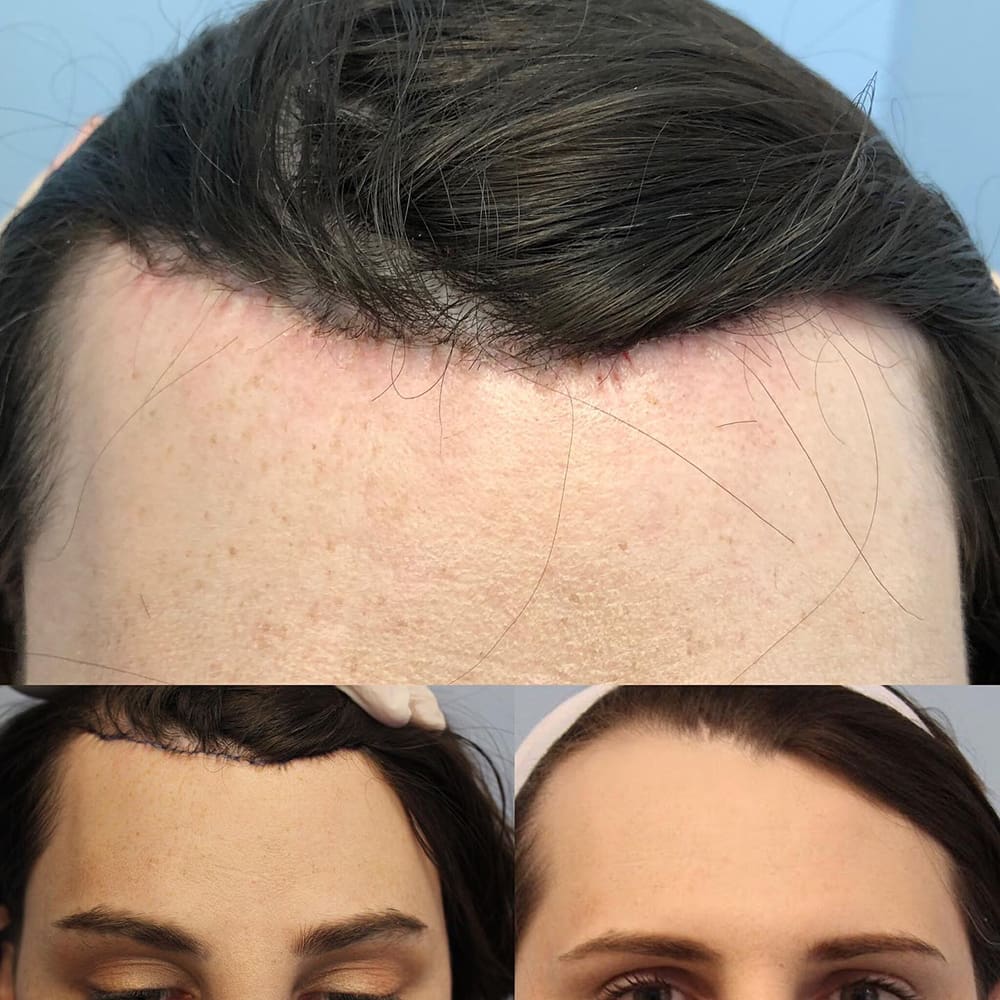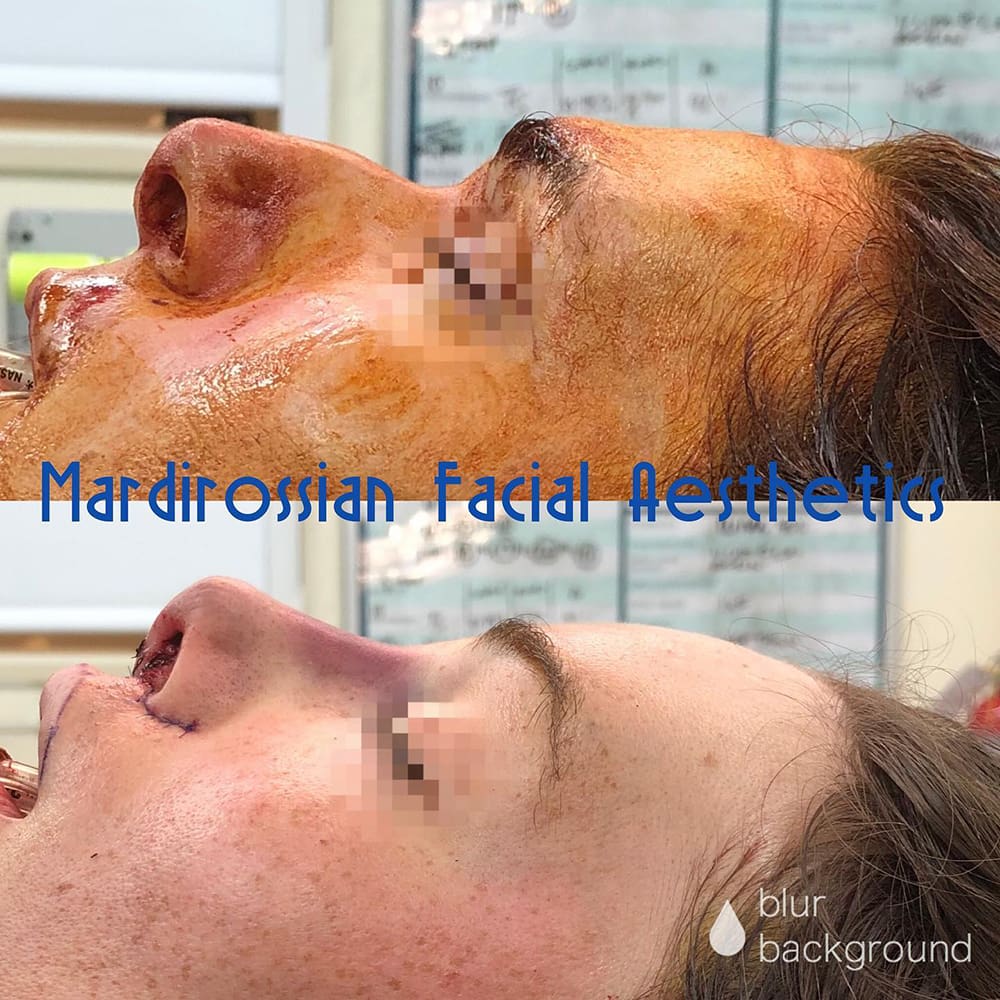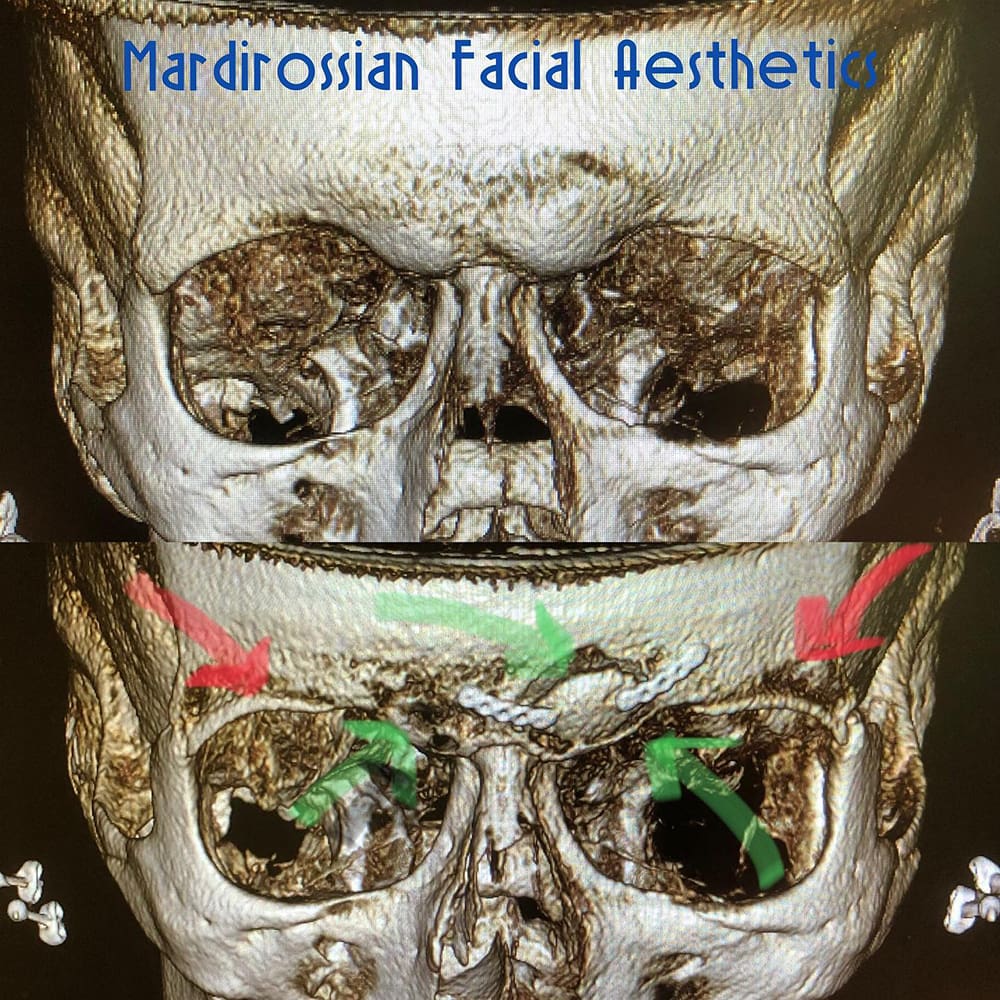Forehead/Brow Lift
in McLean, VA
Forehead contouring is a procedure that benefits patients who desire a smooth and proportionally attractive forehead contour in Virginia including McLean, Falls Church, Tysons, Arlington plus the Washington DC area. It is performed by Dr. Vartan Mardirossian at the Mardirossian Facial Aesthetics fully licensed surgical suite in McLean, VA.
How are the Female and Male Forehead Different?
The female forehead and brow have a soft oval contour that allows the light to flow into the eyes and make them more noticeable. The feminine hairline is oval, and while it is higher in the central portion, its side areas have a rounded shape. The female brows are arched to reach laterally about 1 cm above the lateral orbital rim. In addition, light reflection on naturally prominent cheeks is what helps the women’s eyes to look bigger and more captivating.
In contrast, masculine foreheads are heavier in the area above the eyes, therefore casting a shadow on the eyes and making them appear smaller and less noticeable. The male hairline is often M-shaped with bilateral temporal recessions. The male brows are also generally lower than the female ones and are more horizontal. With the powerful technique of forehead contouring, the excess bone of the forehead above the eyes is removed to enlighten the eyes and have them naturally show their full charm and attractiveness. In addition, the brows are lifted in a more attractive position and the hairline can be advanced and rounded.
Patient Reviews
“I recently had forehead reconstruction surgery performed by Dr. Mardirossian and his team and even though I am still healing, I am extremely happy with the results. I would highly recommend them to anyone looking to get FFS done.“
– G. R.
Preoperative Evaluation of the Forehead: Considerations
When evaluating the forehead preoperatively, there are 4 main elements to consider and discuss with the patient. An important part of this evaluation is based on the cone-beam CT scan (CBCT) of the facial bones performed in our office on every patient prior to facial bone work.
A. The central lower forehead (glabellar area): This is the main area of concern when planning and performing the forehead contouring. This is the area, which when prominent, creates a shadow over the eyes. Its contouring by setback is an important element of forehead contouring and FFS as a whole.
B. The superior orbital rims (supraorbital or brow ridges): Reducing the bone in this area gives the eyes a more enlightened look and eliminates the deep-set eye appearance.
C. The supraorbital area: The area immediately above the superior orbital rims is the area that is shaved to reduce the bony prominence and the downward slope of the forehead, especially in 3/4 view. This creates a more oval shaped and feminine contour.
D. The temporalis muscle and its bony ridges: Some patients can benefit from an overall reduction of the width of the forehead. This is achieved by reducing the temporalis muscle and the bony ridge at its insertion into the temporal bone.
What are the Approaches for Forehead Contouring and How are They chosen?
The available approaches are the a) hairline incision approach and b) the hair (or coronal) approach. An important element to consider in deciding the approach is the height of the hairline. In men, the normal height of the hairline is around 7 cm while in women this distance is 5.5-6 cm when measured from the eyebrows. In men, the central forehead is generally lower than the lateral forehead, and there are temporal hollows of hair loss (M-shaped hairline), while in women it is vice-versa – the central forehead is higher than the sides where the hairline is oval and transitions smoothly into the temporal scalp. In patients who already have a low and oval hairline, we generally prefer a coronal incision hidden in the hair. This will both preserve the naturally oval hairline and will, at the same time, give the perfect access to the forehead bone and will offer the possibility to perform a brow lift. In patients with a high hairline, where there is a need for hairline advancement, the hairline incision approach is preferred. This approach will allow for a 2.5 – 5 cm lowering of the hairline and a rearrangement of the hairline so that the lateral temporal hollows are eliminated. The hairline advancement performed through the hairline incision can be quite powerful: it equates to about 6000 hair transplants.
There are also a number of hybrid incisions available, where the central incision is hidden in the hair and the lateral incisions run at the temporal hairline. This is typically the case where the central hairline does not need to be advanced but the temporal hollows are to be eliminated and replaced with the hair-bearing scalp.
How Do We Camouflage the Hairline Incision?
This is a question that is important to every patient. We take several important steps to improve the healing of the hairline incision to make it virtually invisible when the healing is complete.
A. An irregularly irregular incision mimics the irregular outline of a natural hairline. Each segment in this palisade is 5 mm or less in length. Breaking up the incision in this way makes it less noticeable, as the human eye struggles to perceive incision segments that are less than 5 mm in length on the face. This is a technique we commonly use in our facelift, neck lift, and coronal brow lift incisions as well.
B. An “inclined” or “trichophytic” incision is an incision that transects the hair shafts but preserves the hair follicles. This allows for hair growth through the incision upon completion of the healing, with further camouflage of the incision. This usually happens 4-5 months postoperatively.
C. Avoidance of wound tension upon closure. The concept of this precaution goes back to the surgical technique we use, as well as the cranial suspension we developed for the closure of the skin flaps during the hairline advancement. This allows for a tension-less closure resulting in a very thin, almost hair-thin hairline incision.
D. Multiple layers of closure: We close the wound in 3 to 4 separate layers. This guarantees a minimal to no tension on the wound.
E. The skin is closed with fine bioinert suture material. We choose the thinnest possible suture that is also best tolerated by the skin for our closures. We tend to remove the hairline incision sutures 10-14 postoperatively when the healing is complete.


How is the Forehead “Feminized”?
Once the forehead bone is exposed, its contouring can proceed in the area above and around the eyes per preoperative planning. Some patients have a very thick forehead bone or do not have a frontal sinus and removal of the excess bone can be enough to achieve a nice and smooth reshaping of the frontal bone. However, in the majority of our patients (95%), the frontal sinus lies under a thin layer of bone and may be penetrated if the protruding bone is simply removed. In those cases, the anterior wall of the frontal sinus is removed, reshaped and set back within the context of the frontal sinus to give a smooth and oval contour to the forehead. The central bony fragment that was set back is held in place with two tiny titanium plates held in place with micro-screws. From a surgical perspective, there are three options for reshaping the forehead:
- Option 1: Shaving – Excess bone is shaved and smoothed down for a more feminine appearance. This procedure, however, is only successful in about 5% of patients, who have no frontal sinus.
- Option 2: Shaving and Filling – This is a common procedure, but should only be used when the angle between the nose and forehead is naturally feminine. The concave area just above the bossing is filled (post-shave) with bone cement. The disadvantage of this technique is that it may create a heavy-looking forehead.
- Option 3: Forehead Reconstruction (or Type 3, used in 95% of our patients) – This is the most desired surgical procedure because it involves removing the anterior frontal sinus wall and remodeling it for a smoother shape. While it is the most complex type of forehead contouring, it delivers the best results. This is the procedure we most commonly perform in our practice.
In addition, the superior orbital rims, the supraorbital areas, and the temporalis ridges are shaved to complement and improve the forehead oval.
What Does Recovery Involve Following a Forehead Contouring Procedure?
After the procedure, you should expect to wake up with a soft dressing around your head, which will be removed on the day after the surgery. Then you will be wearing a soft elastic bandage (Ace-wrap) that we usually recommend for 7 days and 7 nights, followed by 7 nights only. Icing is paramount to help with swelling in the initial hours after the procedure. Patients may spend a night in the hospital for observation immediately following a procedure. While swelling is normal, it could last for a few days post-surgery. Discomfort is also common but can be alleviated with prescribed painkillers in the first 12 to 24 hours. On average, it takes patients one to two weeks to return to work and resume regular activities. Sutures are often removed in one-two weeks. Numbness is normal, especially in the forehead and scalp region, and this could be off and on for up to three months. All of our patients are supplied with detailed postoperative instructions already at the time of the preoperative visit.
Contact Mardirossian Facial Aesthetics today to schedule a consultation with Vartan Mardirossian, M.D., F.A.C.S., to see if this procedure is the right solution for you. We offer forehead contouring to patients in Virginia including McLean, Falls Church, Tysons, Arlington plus the Washington DC area.

